unit 5 sports教案22
- 格式:docx
- 大小:66.15 KB
- 文档页数:3
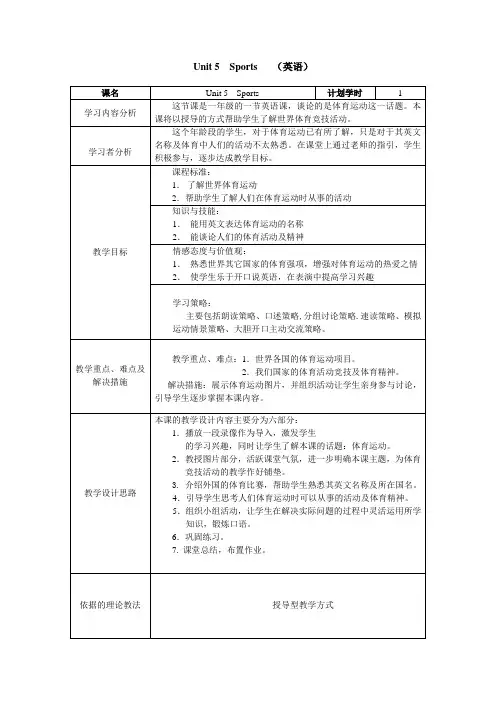
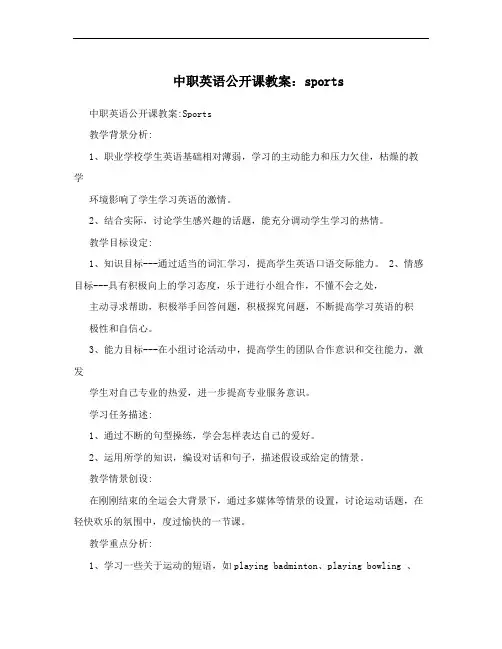
中职英语公开课教案:sports中职英语公开课教案:Sports教学背景分析:1、职业学校学生英语基础相对薄弱,学习的主动能力和压力欠佳,枯燥的教学环境影响了学生学习英语的激情。
2、结合实际,讨论学生感兴趣的话题,能充分调动学生学习的热情。
教学目标设定:1、知识目标---通过适当的词汇学习,提高学生英语口语交际能力。
2、情感目标---具有积极向上的学习态度,乐于进行小组合作,不懂不会之处,主动寻求帮助,积极举手回答问题,积极探究问题,不断提高学习英语的积极性和自信心。
3、能力目标---在小组讨论活动中,提高学生的团队合作意识和交往能力,激发学生对自己专业的热爱,进一步提高专业服务意识。
学习任务描述:1、通过不断的句型操练,学会怎样表达自己的爱好。
2、运用所学的知识,编设对话和句子,描述假设或给定的情景。
教学情景创设:在刚刚结束的全运会大背景下,通过多媒体等情景的设置,讨论运动话题,在轻快欢乐的氛围中,度过愉快的一节课。
教学重点分析:1、学习一些关于运动的短语,如playing badminton、playing bowling 、hurdling、jogging等等。
2、掌握运用句型What kind of sports is it?/ What do you think of---?/Doyou like---?/What sports do you like? 等等。
1教学难点分析:1、根据对话范例,编造相似的对话,表达对运动的爱好。
2、运用所学关于运动爱好的短语和句型,描述设定的情景。
教学资源准备:时间资源:课前、课内、课后的设计与安排材料资源:学案设备资源:多媒体环境资源:多媒体资源信息资源:网络资源教学方法运用:这节课充分运用了Free talk、Pair work、Make up dialogues、Reading、Explanation和Discussion等教学方法,通过启发引导,运用形象的媒体材料,创设情景,讨论热门话题,在轻松愉快的教学氛围中,让学生大胆开口讲英语。

Unit 5 Sport 一、基本知识点(一)词汇sport [spɔːt] n. 体育运动football ['fʊtbɔːl] n. 足球club [klʌb] n. 俱乐部join [dʒɒɪn] v. 参加;加入tell [tel] v. 告诉about [ə'baʊt] prep. 关于basketball ['bɑːskɪtbɔːl]n. 篮球volleyball ['vɒlɪbɔːl]n. 排球us [əs; ʌs] pron. 我们(二)短语table tennis 乒乓球运动play football 踢足球play basketball 打篮球play volleyball 打排球a new football club 一个新的足球俱乐部would like to do = want to do想要做...(三)句型1. I like playing football.2. —Does she like playing football?—Yes, she does./ No, she doesn’t.3.—What does she like doing?—She likes playing table tennis.4.Let’s join the club.(四)重难点、易错点1. play + 球类运动表示“打...; 踢... ”, 注意积累球类运动的词汇2. 学习动词的用法:like to do/ doing sth 喜欢做某事want to do sth 想要做某事let sb do sth 让某人做某事tell sb about sth 告诉某人关于某事3.含有实义动词的肯定句变一般疑问句和特殊疑问句二、典型例题1. ________ Alice like playing football?A.DoB. DoesC. Is2.I like ________ basketball.A.playsB. playC. playing3.Let’s ________ the music club.A.joiningB. joinsC. join4. — Does he like playing the volleyball club?— Yes, ________.A.he likeB. he likesC. he does三、变式习题基础题(一)词汇运动football打篮球关于tellus打排球(二)对话匹配( ) 1. Does Peter like playing table tennis? A. She likes walking.( ) 2. Would you like to come with me? B. Yes, he does.( ) 3. What lessons do we have today? C. Sure.( ) 4. What does she like doing ? D. We have Art, English and Maths. ( ) 5. What subjects do you like? E. I like Maths.提高题(一)单项选择( ) 1. Alice is my friend. I like volleyball. She ________ volleyball, too.A. likeB. likesC. liking( ) 2. They like _______ football in the playground.A. playsB. playC. playing( ) 3. My favorite subject is Art. What ________ you, Kitty!A.forB. toC. about( ) 4. San and I want ________ the club.A. to joinB. joinC.joining( ) 5. —What’s your favorite subject?—My favorite subject is PE because I can ________ in PE class.A. draw a pictureB. play the violinC. play table tennis(二)连词成句1.that’s, idea, a, good (!)_______________________________________________________________2.she, playing, does, like, football(?)_______________________________________________________________3.join, let’s, club, the (.)_______________________________________________________________4.you, want, go, do, with, to, us (?)_______________________________________________________________强化题(一)用所给词的适当形式填空。
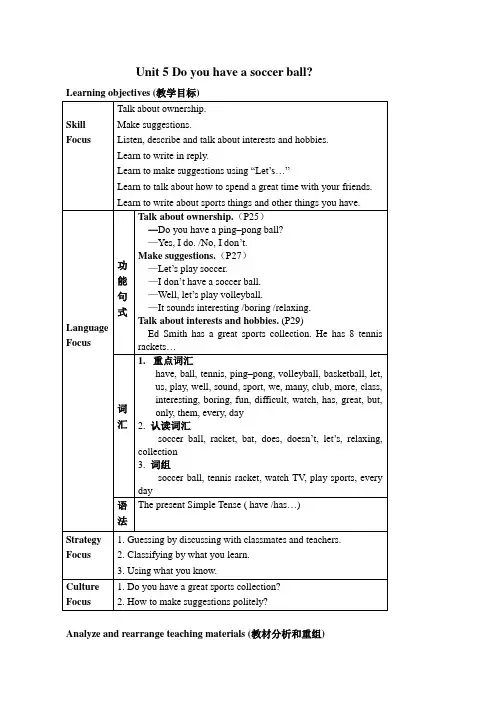
Unit 5 Do you have a soccer ball? Learning objectives (教学目标)Analyze and rearrange teaching materials (教材分析和重组)1. 教材分析本单元以“Do you have a soccer ball?”为话题, 共设计了三个部分的内容。
Section A该部分有4个模块:第一模块围绕“Do you have a soccer ball?”这一话题展开词汇学(1a)、听力(1b)、口语(1c)训练;第二模块继续围绕“Do /Does… have a…?”进行听力(2a-2b)、口语训练(2c);第三模块围绕“Make suggestions.”这一话题展开训练,训练形式为单词填空(3a)和角色表演谈论图画为训练形式(3b);第四模块就“Complete the forms according to the sports club you like.”以结对活动形式进行介绍。
Section B该部分有4个模块:第一模块是词汇的学习(1a)与运用(1b);第二模块仍然围绕(1a-1b) 的词汇进行听力训练(2a-2b)、围绕提建议进行口语训练(2c);第三模块继续围绕“Ownership”这一话题展开有关收藏品阅读(3a), 写作训练(3b-3c);第四模块仍就“Ownership”这一话题以口语训练形式展开全班活动。
Self Check该部分有3个模块:第一模块以填空形式对所学词汇进行训练;第二模块以默写已学过的五个单词的形式对所学的词汇继续巩固复习; 第三模块围绕有关ownership和suggestions对话开展口语训练和写作训练。
教材重组和课时分配Period 1 (Section A: 1a, 1b, 1c) New function presenting Period 2 (Section A: 2a, 2b, 2c, 3a, 3b, 4) PracticePeriod 3 (Section B: 1a, 1b, 2a, 2b, 2c) V ocabulary building Period 4 (Section B: 3a, 3b, 4) Integrating skillsPeriod 5 (Self Check: 1, 2, 3 & Workbook) Self CheckPeriod 6 WritingTeaching procedures and ways (教学过程与方式)Period One New function presentingLanguage goals (语言目标)1. Words & expressions: have, soccer ball, tennis, racket, tennis racket,ping–pong, volleyball, basketball, bat (P25)2.Key sentences: Do you have a ping–pong ball?Yes, I do. No, I don’t. (P25)Ability goals (能力目标)Enable the students to understand and talk about ownership and make suggestions.Emotion & attitude goals (情感和态度目标)Enable the students to form positive attitude toward sports collection and love sports, keep healthy and learn to make suggestions politely. Strategy goals (策略目标)To understand the target language by reading pictures, drawing pictures, countingnumbers, drawing a chart.Culture awareness goals (文化意识目标)People’s attitude toward sports collections is different in English speaking countries.Teaching important points (教学重点)Talk about ownership and make suggestions.Teaching procedures & ways (教学过程和方式)Step 1. Revision and Lead-inAsk one or more students to show their homework.T: In the last unit, I ask you to do a project about filling in the chart because we want to have a ball game. But we don’t know what kind of balls you have. Please ask your classmates in the group what balls he /she has. Then write down the information in the chart. Now who wants to display your project on the blackboard?T: Do you have tennis? S: Yes, I do.Second point to the others in the classroom.T: Does Wang Wei have tennis? S: Yes, he does.Third point to Li Hong in the classroom who has ping–pong ball, but no tennis.T: Do you have tennis?S: No, I don’t.T: Do you have a ping–pong ball?S: Yes, I do.T: Does Li Hong have tennis?Ss: No, she doesn’t.T: Does Li Hong have a ping–pong ball?Ss: Yes, she does.T: Today we are going to learn how to talk about ownership and make suggestions.Step 2. Listing and SpeakingAsk the students to read the picture on Page 25.T: What can you see in the picture?Ss: We can see a ping–pong ball, a ping–pong bat, a tennis racket, a soccer ball, volleyball, a basketball, a TV, a computer game.T: Ask the students to match the words with the things in the picture.Ss: Say, Number 1 is (C), tennis racket. Number 2 is (a), ping–pong ball…After checking the answers in 1a, ask the students to read aloud the new words again and again, ask and answer about them in pairs. And then play the recording again. This time students listen to conversation and circle the words they hear. And then check the answers. Students circle ping–pong bat and computer game.Step 3. Pair workAsk the students to read the example conversation. Have students repeat. And then point to the television in the illustration and substitute that word in the conversation. Have students repeat again. And then ask students to practice the conversation in pairs and remind them to use various objects from the illustration. As students practice, move around the classroom to check progress and help with pronunciation.Ask for more ideas from the students and write their ideas on the blackboard.p hone, cars, pencil case, eraser, pen, book, dictionary, watch, key, notebook, ring, sister , brother, chair, bookcase, CD, video tape, hat, desk, dresser…Show the following to the students and then ask them to practice in pairs.—Do you have a phone?—Yes, I do.—Do you have a CD?—No, I don’t.T: Now work in pairs, make conversations with the newwords in 1a and act it out around the students.Sample conversations:1. S1: Do you have a ping–pong bat?S2: Yes, I do.S1: Do you have a ping–pong bat?S2: No, I don’t.2. S3: Do you have volleyball?S4: Yes, I do.S3: Do you have a basketball?S4: No, I don’t.3. S5: Do you have a tennis racket?S6: Yes, I do.S5: Do you have a TV?S6: No, I don’t.Step 4. Homework1. Ask the students to do more practice as required in 1 c on Page 25.2. Ask the students to prepare the next period. Think about the usage of “Does she /he have…?”Period Two PracticeLanguage goals (语言目标)1. Words & expressions: does, doesn’t, let, us, let’s, play, well, sound,good, sport, we, many, club, more, class (P26)2. Key sentences:—Let’s play volleyball.—That sounds good. (P26)Ability goals (能力目标)Enable the students to make suggestions politely.Emotion & attitude goals (情感和态度目标)Train the Ss to make suggestions politely and take activity part in school sports club and keep healthy.Strategy goals (策略目标)Enable the students to match the problems and worries.Culture awareness goals (文化意识目标)Learn to how to make suggestions politely.Teaching important points (教学重点)Talk about making suggestions.Teaching procedures & ways (教学过程和方式)Step 1. RevisionBefore class, let’s have a revision. First make up a conversation with “Do you have…?”about ownership, and then in threes make up a conversation with “Do you have…? Does she /he have…?”Sample dialogues:1. S1: Do you have a soccer ball? S2: Yes, I do.S1: Do you have a basketball? S2: No, I don’t.2. S1: Do you have a computer game? S2: No, I don’t.S1: Do you have a ping–pong bat? S2: Yes, I do.S3: Does he have a computer game? S1: No, he doesn’t.S3: Does he have a ping–pong bat? S1: Yes, he does.Step 2. Listening PracticePlay the recording for the first time.T: Listen to the tape. You only listen.Play the recording for the second time. Then check the answers.T: You’ll hear the same conversation again in the picture. This time please listen for the names in the pictures, and then number the pictures (1-4).After that ask a few students to say out their answers in 2a.S1: The answers are 3, 1, 4, 2.S2: Number the pictures: 3, 1, 4, 2.Play the recording for the third time.T: You will hear the conversations for the third time. You are to match the people from activity 2a to the balls in the recording for the fourth time and then correct the answers.T: You listen to the tape and write the numbers from the pictures in 2b next to the correct balls.After doing listening, talk about the dialogue about 2b, and then ask some students to say out their answers in 2b.S3: The answers are 3, 2, 1, 4.S4: They are 3, 2, 1, 4.Step 3. Pair workLook at the things in the picture. Ask your partner if he /she has the things in 2c.Ask the students to act out the conversation in pairs.Sample conversations:1. S1: Do you have a dictionary? S2: Yes, I do.S1: Do you have an eraser? S2: No, I don’t.2. S3: Do you have a baseball? S4: No, I don’t.S3: Do you have a football? S4: Yes, I do.3. S5: Does Tom have volleyball? S6: Yes, he does.S6: Does Mike have a pen? S5: No, he doesn’t.Step 4. PracticeLook at 3a, point out the words in the box and then ask a student to read aloud the four words to the class.T: Fill in the blanks with the words from the box alone. I’m sure you’ll fill in the correct answers. And now who’ll tell me the answers? Please hand up if you know the answers. Oh, thank you, --------!S1: The answers are: 1. don’t,2. Let’s,3; have,4. soccer.T: You are right. Thank you. Now let’s practise reading aloud the conversations in pairs and act them out. And then tell the students how to make suggestions politely using “Let’s…!”For example:T: Let’s play ping–pong ball./ Let’s play tennis./ Let’s play volleyball…S: That sounds good.After finishing practising the conversations in 3a, ask the students to make conversations with their partners according to the pictures below in 3b. Ask the students to point to each one and describe each object. Show the students how to use the pairs of pictures as substitutes in the conversation.For example:T: Let’s play basketball.S: I don’t have a basketball.T: Well, let’s play football.S: That sounds good.Ask pairs of students to perform the conversation for the class and tell them how to make suggestions politely in 3b.Step 5. Writing and practiceThis activity gives students a chance to role play a conversation about sports. Students review the language of introductions, and then complete the form, introduce themselves to the coach.T: What sports do you like to play? Who are your favorite sportsmen and sports women? What sports are available at school?S1: I like to play football. My favorite sports man is Liu Xiang. Basketball and volleyball are available at our school.T: Our school has a sports Club with all the sport that you would like to play. If you would like to join the school sports club, please fill in the form with your personal information. When students have completed filling in the form, divide them into pairs.T: Wha t’s your first name? What’s your last name? What sports do you like? Do you like…? What class are you in?S: My first name is Li. My last name is . I like ping–pong ball. I’m in Class 4, Grade 7.Have students role play the conversation between a student and coach. Walk around the class and offer help where necessary.Step 6. SummaryAsk some students to sum up what we have learned key vocabulary and the target languages.Step 7. Today’s homeworkT: First make up dialogues with “ownership and make suggestions” in pairs /in groups. Next class I’ll ask you to act them out. Second, prepare for the next class P 28 (1a, 1b, 2a, 2b, 2c).Period Three New vocabularyLanguage goals (语言目标)1.Words & expressions:interesting, boring, fun, difficult,relaxing, watch, watch TV (P28)2. Key sentences: (1) Let’s play computer games.(2) That sounds interesting. (P28)Ability goals (能力目标)Enable the students to learn to make suggestions politely and responses.Emotion & attitude goals (情感和态度目标)Enable the students to learn to express their feelings about different suggestions.Strategy goals (策略目标)Enable the students to know how to express their feelings aboutdifferent suggestions.Culture awareness goals (文化意识目标)Different countries, different suggestions.Teaching important points (教学重点)Learn to how to express different suggestions and responses. Teaching procedures & ways (教学过程和方式)Step 1. Revision and word studyCheck the homework:T: Last class we asked the students to make up conversationswith “ownership and make suggestions”in pairs /ingroups. Now we’ll ask you to act them out.Point to the five words and ask the students to repeat each one,and then point to the five pictures and ask the students tomatch each picture with one of the words in section B (1a).Ask the students to write the letter of the picture on the linenext to each word.Ask the students to say out the answers. Go around the room,asking students to point to a picture and say the word that goeswith that picture. The answers are: 1. c; 2. d; 3. e; 4. b; 5. a.Step 2. Guessing the wordsThis activity makes students practise using the vocabularywords from this unit. Point to the picture in 1a and reviewthe words.T: Now please draw pictures that show somethinginteresting, boring, fun, difficult or relaxing. Please showyour pictures to some of your classmates. Everyone triesto guess the meaning.Step 3. Listening and word studyBefore playing the recording for the first time, point out thefive words in 1a above and ask a student to read them aloudto the class.Play the recording for the first time in 2a.T: Listen to the tape carefully and remember the fouradjective words you hear.Play the recording for the second time.T: Listen to the conversation and put a checkmark to the leftof each word in 1a that you hear.Ask the two students to say out their answers.Ss: The answers are: a. interesting; b. boring; c. fun;d. difficult;e. relaxing.Step 4. Listening and writingT: I’ll ask a student to read the name of each activity to theclass. And then I’ll play the tape. Listen to the tapecarefully for the first time and remember what Tony saysabout these activities. I’ll play the recording again. Thistime listen to the conversation and write the word in theblank.After listening to the tape for the second time, ask somestudents to read the same example to the class.Ss: The answers are: 1. interesting; 2. difficult; 3. boring; 4. fun.Step 5. Practice and actingBefore asking the two students to read the dialogues, listthese activities on the blackboard: play computer games,play volleyball, watch TV, play basketball.T: I’ll ask the two students to act out the dialogues, talkingabout the activities in 2b.One acts as Jenny, the other acts as Tony, move around theclassroom offering languages support and checkingprogress when the students talk about the activities. Ask afew pairs of students to perform their conversations for theclass.Sample dialogues:1. S1: Let’s play volleyball.S2: That sounds fun.2. S3: Let’s watch TV.S4: That sounds boring.Step 6. Summary1. This class we have learned how to make suggestions andresponses politely. We also have learned how to use somedescription adjectives.2. Prepare for the next class.Step 7. Today’s homework1. Make up dialogues about “Make suggestions and responses”.2. Prepare for the next lesson.Period Four Integrating skillsLanguage goals (语言目标)1. Words & expressions:has, great, collection, but, play sports,only,them, a great sports collection, tennis racket, soccer ball, onTV, everyday (P29)2.Key sentences: (1) Ed Smith has a great collection.(2) But he doesn’t play sports—he only watches them on TV.Ability goals (能力目标)Train the ability of the students about reading and writing.Emotion & attitude goals (情感和态度目标)Enable students to form wide interests and hobbies.Strategy goals (策略目标)Enable students to collect what they like.Culture awareness goals (文化意识目标)Enable students to understand different people have different interests and hobbies.Teaching important & difficult points (教学重点和教学难点)1. The plural form of noun.2. The Present Simple TenseTeaching procedures & ways (教学过程与方式)Step 1. RevisionFirst check the homework, and then ask a few pairs to act out the conversation about: Making suggestions and responses.T: Who can make up a dialogue about making suggestions and responses in pairs?S1: Let’s play football.S2: That sounds fun, but I don’t have a football.S1: Well, do you have a basketball?S2: Yes, I do.S1: Then let’s play basketball.S2: Oh, basketball is so different.S1: OK. Let’s play ping–pong ball.S2: That sounds boring. Let’s play computer game! Do you havea computer?S1: Yes, I do.S2: That sounds interesting.Step 2. ReadingBefore reading this magazine article, ask students to name everything they see in the picture (3a).T: Read the article by yourself, and then circle the vocabulary words that are about sports activities.Give examples such as a stamps collection or a coin collection.T: Please close your books, look at the overhead projector, listen to me carefully, and then fill in the blanks with the sports things in 3a. Please tell the students the answers.S1: 1. tennis racket; 2. basketball; 3. baseball; 4. soccer ball; 5. volleyballT: Y ou’re right. OK. Thank you! Pay attention to the usage of thePresent Simple Tense and the plural form of noun.Explain the usage of the grammar and some key sentences, ask the students to retell the text next class.Step 3. Reading and writingBefore reading this article, ask students to name everything they see in the picture (3b). And then read the article to the class. Ask students to look at the picture and fill in the blanks by themselves. After that, let the students correct the answers in pairs. Ask three students to write their answers on the blackboard. (The answers are: 1. baseball; 2. basketball; 3. tennis rackets; 4. volleyball.)After finishing filling in the blanks, explain the usage of the Present Simple Tense, the plural form of noun and some key words, key sentences. Ask students to recite the text (3b).Step 4. Writing and SpeakingT: After finishing learning the articles about 3a and 3b, now you write about yourself. Talk about your hobbies and interests such as:What sports do you play?What sports things do you have?What other things do you do? And so on.After a while I’ll ask some students to read their stories to the class.S1: I collect coins. I have ten American coins, five Russian coins.S2: I have a great toy cars collection. I have two Chinese toy cars, threeJapanese toy cars, four British toy cars. I play them every day.Step 5. Spoken English and writingNow look at 4 Survey, write “have,you, an alarm clock, do”on the blackboard.T: Please say the words in the correct order to make a question. Come tothe blackboard, Wang Fei.S1: Do you have an alarm clock?T: OK, you’re right. Thank you. Please write a student’s name under thequestion on the blackboard. Who can do it? OK, Yang Fan, please.S2: Li Gang.T: OK, Li Gang, please come to the blackboard. Do you have an alarm clock?Guide him to answer “Yes, I do. /No, I don’t.”S3: Yes, I do.T: Now, please write four questions like this. After that ask students to say other things they might ask. As the students complete the questions, move around the classroom checking progress and offering suggestions as needed, at the same time ask students to move around the room, asking their questions and writing in names. In this way the students learn the target language easily. Step 6. Today’s homework1. Write a story about your /his /her collection.2. Make up dialogue with “Do you have…?”3. Finish off all the exercises on the small blackboard.Period FiveLanguage goals (语言目标)1. Words & expressions: basketball, tennis racket, baseball bat, ping–pong ball,soccer ball, volleyball, interesting, boring, run, difficult, relaxing, TV2. Key sentences: (1) Do you have a ball? Yes, I do.(2) —Let’s play soccer.—That sounds good./It’s boring.Ability goals (能力目标)Train students’ writing abilities.Emotion & attitude goals (情感和态度目标)Learn to talk about ownership and make suggestions.Strategy goals (策略目标)Enable students to form wide interests and hobbies.Culture awareness goals (文化意识目标)Enable students to understand the different countries have different suggestions and hobbies.Teaching important & difficult points (教学重点和教学难点)Learn to how to talk about ownership and make suggestions. Teaching procedures & ways (教学过程与方式)Step 1. RevisionBefore class ask a few students to read aloud the stories about themselves, and then have some pairs act out dialogues about ownership. Also give students three minutes to have a free talk.Step 2. Words checkingThis activity provides a comprehensive review of key vocabulary presented in this unit.T: Now let’s go over key vocabulary in this unit. I speak Chinese, you speak English. First answer my questions one by one, and then answer my questions together. OK let’s begin.有趣的,无聊的,休闲的……篮球,网球球拍……Ss: Interesting , boring, relaxing…T: OK, so much for this. Now take out your English exercises books, write five new words in it, and then share your lists with your groups.Step 3. Reading and writingThis activity focuses on students understanding of the target language in the unit.T: Please read aloud the following sentences in 3a, and then number the sentences to make a conversation that follows the situations in the pictures by yourself.After a while, check the students’ answers. The answers are: 5, 1, 4, 2, 3, 6, 7.After checking the answers, ask the students to act out the dialogue and recite it.T: Now look at the chart on the blackboard with the names of five activities and five words at the top: interesting, boring, fun, difficult, relaxing. And then make up a dialogue talking about ownership and makingAsk two students to act out the dialogue.S1: Let’s play baseball!S2: That sounds interesting, but I don’t have a baseball.S1: …S2: …Step 4. Group workT: The class ball games will be held soon. The students in the class are training recently. Please give suggestions to your group and ask them to train after class.As you make up conversations, please use the drills “Do you have a…? /Yes, I do. /No, I don’t / Let’s… /No, it’s boring.”Step 5. Homework1. Finish off all he exercises in the workbook.2. Talk about your friends’hobbies. (play basketball /soccer ball /ping–pong ball /watch TV /play computer games /play sports every day)Period Six Writing(ppt展示)Teaching Resources (教学资源库)1.语法:(1) 名词复数的构成及读音规律:特别提醒:名词复数的不规则变化是:①只变元音字母,如:man—men, woman —women, foot—feet, policeman—policemen ②单复数形式一样,如:a fish—some fish, a Japanese —some Japanese ③其它变化,如:child—children等。
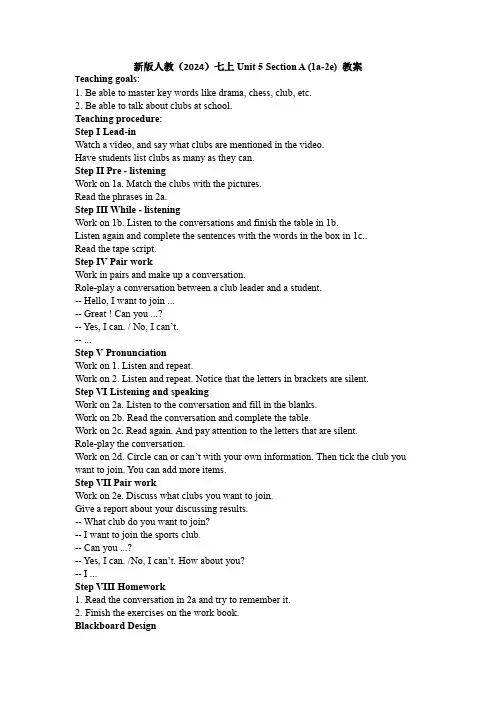
新版人教(2024)七上Unit 5 Section A (1a-2e) 教案T eaching goals:1.Be able to master key words like drama, chess, club, etc.2.Be able to talk about clubs at school.Teaching procedure:Step I Lead-inWatch a video, and say what clubs are mentioned in the video.Have students list clubs as many as they can.Step II Pre - listeningWork on 1a. Match the clubs with the pictures.Read the phrases in 2a.Step III While - listeningWork on 1b. Listen to the conversations and finish the table in 1b.Listen again and complete the sentences with the words in the box in 1c..Read the tape script.Step IV Pair workWork in pairs and make up a conversation.Role-play a conversation between a club leader and a student.-- Hello, I want to join ...-- Great ! Can you ...?-- Yes, I can. / No, I can’t.-- ...Step V PronunciationWork on 1. Listen and repeat.Work on 2. Listen and repeat. Notice that the letters in brackets are silent.Step VI Listening and speakingWork on 2a. Listen to the conversation and fill in the blanks.Work on 2b. Read the conversation and complete the table.Work on 2c. Read again. And pay attention to the letters that are silent.Role-play the conversation.Work on 2d. Circle can or can’t with your own information. Then tick the club you want to join. You can add more items.Step VII Pair workWork on 2e. Discuss what clubs you want to join.Give a report about your discussing results.-- What club do you want to join?-- I want to join the sports club.-- Can you ...?-- Yes, I can. /No, I can’t. How about you?-- I ...Step VIII Homework1.Read the conversation in 2a and try to remember it.2.Finish the exercises on the work book.Blackboard DesignHow do you choose a school club?What club do you want to join?I want to join the ...Can you ...?新版人教(2024)七上Unit 5 Section A Grammar focus教案T eaching goals:1.Be able to master key words like climb, musical, instrument, sing, etc.2.Be able to talk about abilities using can.Teaching procedure:Step I Lead-inShow some pictures and ask students the question:Can you play football/basketball/the piano/ ...What can you do?Have them talk about their abilities.Step II PresentationRead the sentences in grammar focus.Pay attention to the word “can”.Step III Group workWork in groups and talk about how to use “can”. Think and talk about the following questions:1.What’s the meanings of “can”?2.Where do we put the word “can” in the question sentences?3.How to answer to the questions with “can” in the beginning?Make a conclusion about the usage of “can”.Have students make some sentences with “can”.Step IV ExerciseWork on 3b. Match the parts to make sentences. Then make more sentences with “can”.Check the answers and read the sentences.Finish the exercises in 3c. complete the passage with the words in the box.Step V Pair workInterview your classmates and tick can or can’t. Then give a report.Step VI Homework1.Read and try to remember the sentences in the grammar focus.2.Finish exercises in this unit on the work book.Blackboard DesignWhat can you do?Can you ...?Yes, I can. / No, I can’t.What club do you want to join?I want to join the ...club.T eaching goals:1.Be able to master key words like mind, fall, nature, etc.2.Be able to find out what people do in different clubs.Teaching procedure:Step I Lead-inShow them some pictures of different clubs. And practice the following talk:-- What can you do?-- I can ...-- Can you ...?-- Yes, I can. / No, I can’t.-- What club do you want to join?-- I want to join the ... club.Step II ReadingRead the comments from some students and discuss what clubs they should join.-- I’m good at telling stories. I often act out stories with my brother at home.-- I’m interested in nature. I love hiking, and I can read maps.-- I can’t cook, but I love great food. I want to cook for my family.Read the ads. Choose a mistake club for each student in 1a and tell your reasons. Read again and complete the table in 1c.Step III Pair workWork in pairs and discuss the following questions:1.What food can you cook? What other food do you want to learn to cook?2.What can you learn from a book club?3.What do you want to be in a nature club?Complete the email with the words in the box.Read the ads again. And circle key words.Step IV Language points1.learn to do sth2.You name it.3.more than4.act out5.make friends with sb6.aall in love withStep V WritingWork on 2b. Choose one club from 2a. Write an email to the organizer and say why you’d like to join the club.Step VI Homework1.Polish your writing.2.Finish exercises in this unit on the work book.Blackboard DesignI wan to join .... I have some reasons. / Let me tell you why. First of all, ....T eaching goals:1.Be able to master key words robotics, team, contact, etc.2.Be able to know how to start your own club.Teaching procedure:Step I RevisionAsk students what club they want to join.Work on 3a. Think of a club you would like to set up in your school.Read the ad in 3a. And think about how to write an ad for a club.Step II Group workWork in groups. Interview your classmates. Find new members for your club. -- Can you work well with your hands?-- Yes, I can.-- Can you come at 12:30 p.m. on Tuesday?-- Yes, I can. / No, I can’t.Step III Show timeMake a report about your group members’ situations.Step IV ReflectingAll students finish the table according to their own situation.Step V Homework1.Read and remember the words in this unit.2.Finish exercises in this unit on the work book.Blackboard Designbe interested in / have an interest inlook forwork well with ...think up new ideas = come up with new ideaswork as a team。
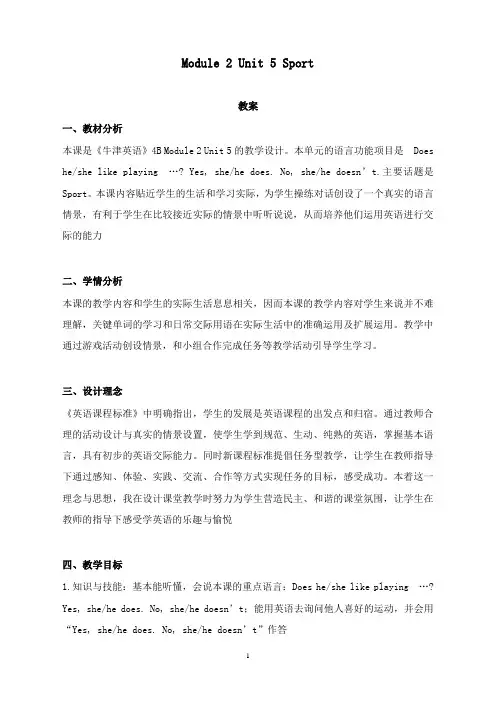
Module 2 Unit 5 Sport教案一、教材分析本课是《牛津英语》4B Module 2 Unit 5的教学设计。
本单元的语言功能项目是Does he/she like playing …? Yes, she/he does. No, she/he doesn’t.主要话题是Sport。
本课内容贴近学生的生活和学习实际,为学生操练对话创设了一个真实的语言情景,有利于学生在比较接近实际的情景中听听说说,从而培养他们运用英语进行交际的能力二、学情分析本课的教学内容和学生的实际生活息息相关,因而本课的教学内容对学生来说并不难理解,关键单词的学习和日常交际用语在实际生活中的准确运用及扩展运用。
教学中通过游戏活动创设情景,和小组合作完成任务等教学活动引导学生学习。
三、设计理念《英语课程标准》中明确指出,学生的发展是英语课程的出发点和归宿。
通过教师合理的活动设计与真实的情景设置,使学生学到规范、生动、纯熟的英语,掌握基本语言,具有初步的英语交际能力。
同时新课程标准提倡任务型教学,让学生在教师指导下通过感知、体验、实践、交流、合作等方式实现任务的目标,感受成功。
本着这一理念与思想,我在设计课堂教学时努力为学生营造民主、和谐的课堂氛围,让学生在教师的指导下感受学英语的乐趣与愉悦四、教学目标1.知识与技能:基本能听懂,会说本课的重点语言:Does he/she like playing …? Yes, she/he does. No, she/he doesn’t;能用英语去询问他人喜好的运动,并会用“Yes, she/he does. No, she/he doesn’t”作答2.过程与方法:在真实的语言环境中,认识语言,理解语言。
执行任务的过程中,激发兴趣,学以致用。
在合作中,拓展思维,促进表达。
3.情感态度价值观:创设任务情景,让学生乐于参与和表达;能积极参加体育运动,强健体魄。
五、教学重难点:能用句型Does he/she like playing …?去询问他人喜好的运动,并会用“Yes, she/he does. No, she/he doesn’t”作答。

Unit5SportsandGames英语教案Unit5SportsandGames英语教案一.教学内容:Lesson17Hecanthrowtheshotput.Lesson18Canyoudive?二.重点、难点:1.学习有关运动名称的词语2.把握情态动词can的用法3.不定代词all,most,some,afew,none的理解和应用 Lesson17Hecanthrowtheshotput.I.WordsStudy单词学习:sportthrowhurdleracelongjumphighjumpshotput 800-meterruneventtrackfieldtrackandfieldevent overknowcompetitionfasteasybegoodatclimbropecartwheelsit-upsomersaultpushuphandstandLesson18Canyoudive?I.WordsStudy单词学习:questionsurveyaheadsurediveinterviewsurf skatenextnonetabletennisbaseballvolleyball II.ExpressionPatterns常用的表达方式:1.有关体育运动的.名称100-meterrace100米接力400-meterrun400米赛跑longjump跳远highjump跳高shotput铅球110-meterhurdles110米跨栏doacartwheel侧翻climbarope爬绳子doahandstand倒立dosit-ups仰卧起坐doasomersault翻跟头dopushups俯卧撑skateboard滑板surf冲浪dive跳水2.情态动词cancan是情态动词,表示“能,会”。
没有人称和数的变化。
其后跟动词原形。
(1)can用于陈述句,表示能干,有力量做某事。
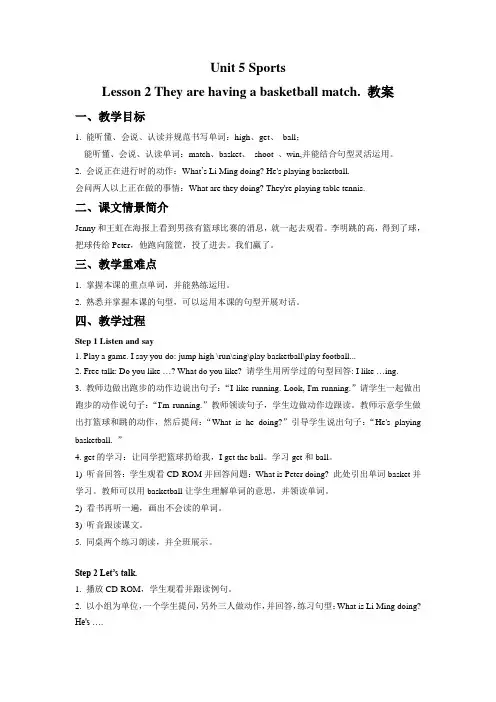
Unit 5 SportsLesson 2 They are having a basketball match. 教案一、教学目标1. 能听懂、会说、认读并规范书写单词:high、get、ball;能听懂、会说、认读单词:match、basket、shoot 、win,并能结合句型灵活运用。
2. 会说正在进行时的动作:What’s Li Ming doing? He's playing basketball.会问两人以上正在做的事情:What are they doing? They're playing table tennis.二、课文情景简介Jenny和王虹在海报上看到男孩有篮球比赛的消息,就一起去观看。
李明跳的高,得到了球,把球传给Peter,他跑向篮筐,投了进去。
我们赢了。
三、教学重难点1. 掌握本课的重点单词,并能熟练运用。
2. 熟悉并掌握本课的句型,可以运用本课的句型开展对话。
四、教学过程Step 1 Listen and say1. Play a game. I say you do: jump high \run\sing\play basketball\play football...2. Free talk: Do you like …? What do you like? 请学生用所学过的句型回答: I like …ing.3. 教师边做出跑步的动作边说出句子:“I like running. Look, I'm running.”请学生一起做出跑步的动作说句子:“I'm running.”教师领读句子,学生边做动作边跟读。
教师示意学生做出打篮球和跳的动作,然后提问:“What is he doing?”引导学生说出句子:“He's playing basketball. ”4. get的学习:让同学把篮球扔给我,I get the ball。
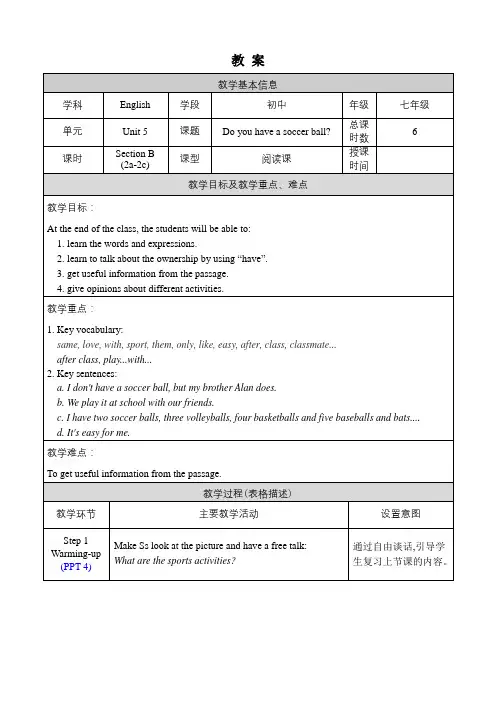
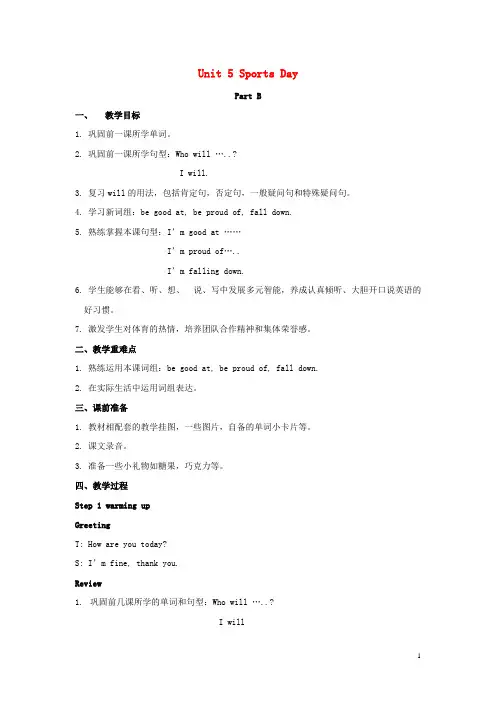
Unit 5 Sports DayPart B一、教学目标1. 巩固前一课所学单词。
2. 巩固前一课所学句型:Who will …..?I will.3. 复习will的用法,包括肯定句,否定句,一般疑问句和特殊疑问句。
4. 学习新词组:be good at, be proud of, fall down.5. 熟练掌握本课句型:I’m good at ……I’m proud of…..I’m falling down.6. 学生能够在看、听、想、说、写中发展多元智能,养成认真倾听、大胆开口说英语的好习惯。
7. 激发学生对体育的热情,培养团队合作精神和集体荣誉感。
二、教学重难点1. 熟练运用本课词组:be good at, be proud of, fall down.2. 在实际生活中运用词组表达。
三、课前准备1. 教材相配套的教学挂图,一些图片,自备的单词小卡片等。
2. 课文录音。
3. 准备一些小礼物如糖果,巧克力等。
四、教学过程Step 1 warming upGreetingT: How are you today?S: I’m fine, thank you.Review1.巩固前几课所学的单词和句型:Who will …..?I will2.巩固will 的几种形式。
Step2 Presentation1.教师带领学生学习新词组。
2.教师展示跑步图片:He is running 100 meters. He is running very fast. He is goodat it.3.继续展示跑步图片,引导学生说: We are proud of him.4.教师展示跳高图片:He is doing high jump, he is falling down, he is not goodat it.Step 3 practice1.教师请同学开火车,第一个同学说一句话,后面的同学接下去,要求用到所学的词组。
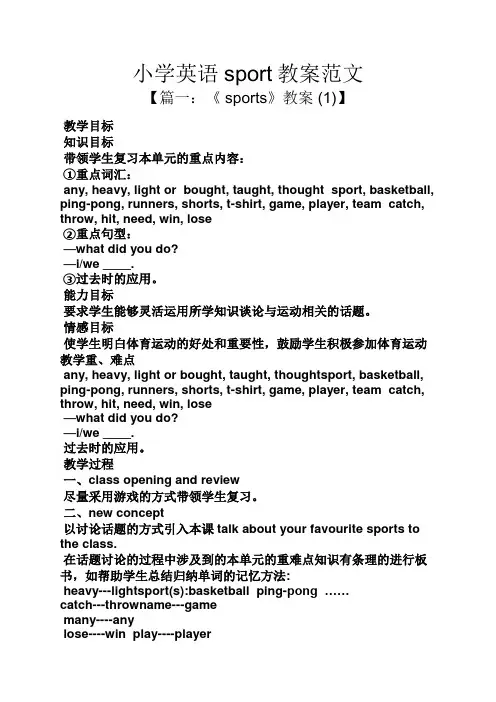
小学英语sport教案范文【篇一:《 sports》教案 (1)】教学目标知识目标带领学生复习本单元的重点内容:①重点词汇:any, heavy, light or bought, taught, thought sport, basketball, ping-pong, runners, shorts, t-shirt, game, player, team catch, throw, hit, need, win, lose②重点句型:—what did you do?—i/we ____.③过去时的应用。
能力目标要求学生能够灵活运用所学知识谈论与运动相关的话题。
情感目标使学生明白体育运动的好处和重要性,鼓励学生积极参加体育运动教学重、难点any, heavy, light or bought, taught, thoughtsport, basketball, ping-pong, runners, shorts, t-shirt, game, player, team catch, throw, hit, need, win, lose—what did you do?—i/we ____.过去时的应用。
教学过程一、class opening and review尽量采用游戏的方式带领学生复习。
二、new concept以讨论话题的方式引入本课talk about your favourite sports to the class.在话题讨论的过程中涉及到的本单元的重难点知识有条理的进行板书,如帮助学生总结归纳单词的记忆方法:heavy---lightsport(s):basketball ping-pong ……catch---throwname---gamemany----anylose----win play----playershort----shorts对话的方式复习三种时态师:what sports do you like to play?ss: i like to play……t: guess what sports i like to play?(师做出相应的动作)ss: you like to play ping-pong.t: i am playing ping-pong.yesterday i played ping-pong.tomorrow i am going to play ping-pong. what about you ? ss imitate the teacher.针对本单元的重点知识出一个小型的测试卷对学生进行检测。
一:教学内容:Unit5 lesson 1 : Listen and say, Let’s talk, Let’s do.二:教学目标:(一)知识目标:1:学生能够听、说、认读club,table tennis,join,oops.2:学生能听、说、认读、规范书写单词:try again.3:能够听懂、会说、认读并运用句型:“What club would you like to join?”“I’d like to join the Table Tennis Club,I like table tennis.”(二)能力目标:能够运用所学句型谈论自己及伙伴喜欢的体育运动。
(三)情感目标:了解俱乐部的相关情况,了解团队合作的重要性,明白体育运动有助于身体健康,养成多做运动的好习惯。
三:教学重点:在情景中恰当运用句型:“What club would youlike to join?”“I’d like to join the Table Tennis Club,I like table tennis.”四:教学难点:1、table tennis , join的发音。
2、能够在实际语境中正确运用所学句型。
五:教学方法:情景教学法交际型教学法任务型教学法合作学习法六:教具:多媒体点读机词卡篮球奖励贴俱乐部标牌七:教学过程:课前根据学生喜好分好俱乐部,通过一起喊口号等方式增加团队凝聚力,激发学生学习热情并宣布今天几个俱乐部之间将有场比赛,积极回答问题获得最多小奖牌的俱乐部将获得一份礼物;布置任务:组建学校的俱乐部并发展壮大。
(一)热身(Warming up.)1. Greeting.T: Hello, children,It’s so glad to see you today ,What’s the weather like today? Do you want to do some sports?Let’s do! T:What sports do you like?What’s your slogan? Ss....【设计意图:通过freetalk引出课题sports,通过做运动热身感受sports,活跃气氛。
牛津深圳版英语九下Unit 5《Sport》说课稿5一. 教材分析牛津深圳版英语九下Unit 5《Sport》是一篇关于体育运动的单元,通过本单元的学习,学生能够掌握关于体育运动的一些基本词汇和表达方式,同时了解体育运动对身体健康的重要性。
本单元的主要内容包括不同种类的体育运动,学生喜爱的运动项目,以及运动对身体的好处等。
二. 学情分析九年级的学生已经具备了一定的英语基础,对于一些基本的词汇和语法知识已经有所了解。
但是,他们在语言表达和听力理解方面还存在一定的困难。
因此,在教学过程中,我将会关注学生的个体差异,尽量采用简单明了的语言进行教学,并给予他们足够的时间和机会进行练习。
三. 说教学目标1.知识目标:学生能够掌握关于体育运动的一些基本词汇和表达方式,如“sport”,“exercise”,“health”等。
2.能力目标:学生能够运用所学知识进行简单的交流,如介绍自己喜欢的运动项目,谈论体育运动对身体的好处等。
3.情感目标:通过本单元的学习,学生能够认识到体育运动对身体健康的重要性,激发他们积极参与体育活动的兴趣。
四. 说教学重难点1.重点:学生能够掌握关于体育运动的基本词汇和表达方式。
2.难点:学生能够运用所学知识进行实际的交流和运用,如介绍自己喜欢的运动项目,谈论体育运动对身体的好处等。
五. 说教学方法与手段1.教学方法:采用任务型教学法,让学生在实际的任务中运用所学知识,提高他们的语言实际运用能力。
2.教学手段:利用多媒体课件、图片、卡片等辅助教学,增加课堂的趣味性和互动性。
六. 说教学过程1.导入:通过提问方式引导学生谈论他们喜欢的体育运动,激发学生的学习兴趣。
2.新课呈现:通过展示图片和多媒体课件,引入本节课的主要内容,教授相关词汇和表达方式。
3.课堂练习:设计不同类型的练习题,让学生进行听力、口语和笔头的练习,巩固所学知识。
4.任务型活动:设计一个关于体育运动的小组活动,让学生在实际的任务中运用所学知识。
小学英语学习材料金戈铁骑整理制作Unit 5 SportsLesson2 They are having a basketball match.一、教材分析:通过一场男生篮球赛,在语境中学习并初步运用所学词组描述比赛中队员的表现。
二、教学目标:1.知识、技能目标能听、说、认读本课的核心单词;能在情境中学习动词词组jump high, get the ball, run to the basket, shoot the ball.并描述比赛中队员的表现。
2.情感目标了解团队合作在比赛中的重要性,培养学生的团队意识。
3.教学重、难点:能在情境中学习动词词组jump high, get the ball, run to the basket, shoot the ball.并描述比赛中队员的表现。
四、教具准备:PPT,单词卡五、教学流程:Step1:Warmer1.教师出示Jenny, Peter, Guo Yang和Danny的头像,问:“They have sports clubsin their school. What are the clubs?”2.Free talk: What club would you like to join?I’d like to join …Step2:Presentation1. 出示文本图片1 T:Look! The boys are having a basketball match between Class1 and Class2. (教授单词match, 图片拓展football match, table tennis match, swimming match强化match的用法)(1) Let's watch the video.(2) Answer the question:Who win?(教授单词win, 由winner到win)2.出示文本图片2:引导学生关注Li Ming, Can Li Ming jump high?(图片引导学生体验感知He jumps very high. He has the ball.)3.出示文本图片3:Listen and answer: How about Peter? What’s he doing? (教授单词basket,shoot) Step3. Practice1.Listen and imitate.2.小小配音员。
闽教版小学英语第六册Unit5 Sports Day Part A教学设计教学目标一、语言知识目标1.学习并掌握以下词汇:Sports Day,meter,long jump,high jump;2.学习并理解以下词汇:fast , try3.学习并运用以下句型:We are going to have a Sports Day.A: Who will…?B: I will.4.话题:能够初步运用所学句型谈论学校运动会。
二、语言技能目标1.能认读和正确书写有关运动项目的词汇。
2.能表达自己打算在运动会上参加哪些运动项目。
3.能用所学语言询问他人所擅长的运动项目并制订运动会报名表。
三、情感态度运用谚语:Life depends on sports.告诉学生生命在于运动,增强学生的健身意识。
教学重难点1.认读和正确书写有关运动项目的词汇:have a Sports Day, run 100 meters, do long jump, do high jump;2.能运用所学词汇表达自己打算在运动会上参加哪些运动项目。
3.能用所学语言询问他人所擅长的运动项目并制订运动会报名表。
教具准备单词卡片、教学幻灯片、教学光盘、评价物品。
教学步骤Step1 Warming up1.Greetings.2.Say a chant.(设计意图:师生互打招呼,使学生进入英语学习氛围。
介绍评价机制,调动学生积极性。
通过学唱歌谣,复习旧知活跃课堂气氛。
)Step2 Lead-inT: Look, It’s a plan for our school. On March 12th we are going to plant trees. On April 5th we are going for a spring outing. What about on May 10th?Ss: have a sports day.T: Yes, we are going to have a Sports Day. Today we are going to learn Unit 5 SportsDay Part A.Teach: sports day, have a sports day, we are going to have a sports day.(设计意图:通过学校计划表,引出课题Sports Day. 在教学Sports Day时,渗透语音教法。
新人教版七年级上册英语教案 Unit5Jump up if you hear a sport!" and hold up cards with different sports written on them。
Students should jump up when they hear the sport that matches the card.3.Review the vocabulary from the us unit。
including words like "book"。
"pencil"。
and "desk".II。
XXX1.Introduce XXX: tennis racket。
ping-pong ball。
soccer ball。
basketball。
and TV。
Show pictures of each item and say the name of the item.2.Model XXX:Do you have a tennis racket?Yes。
I do.Does he have a soccer ball?No。
XXX't.3.XXX.III。
n1.Ask students to work in pairs or small groups to create their own XXX descriptive adjectives to talk about the items they own.2.Select a few pairs or groups to share their ns with the class.XXX1.Review the XXX a game like "Simon Says" or "Teacher Says"。